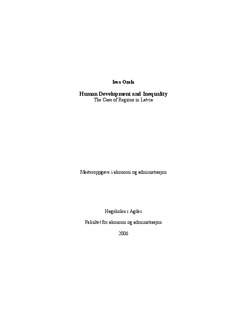Human development and inequality: the case of regions in Latvia
Master thesis
Permanent lenke
http://hdl.handle.net/11250/135418Utgivelsesdato
2006Metadata
Vis full innførselSamlinger
Sammendrag
The main goal of this paper is to address the wellbeing of the population in Latvia by
using the tools created by the UNDP, as presented in Part 1. The analysis is called for
based on growing concerns over increasing inequality within Latvia, and the theoretical
assertions about the negative effect of such a development on achieving sustainable
economic growth in the longer term.
The paper consists of three main parts: Introduction, Analysis and Conclusions.
The INTRODUCTION lays out the background for the paper, the statement of the problem,
and the focus and constraints of the paper.
The ANALYTICAL part of the paper is an extension of the analysis performed in Part 1.
Whereas in Part 1 I conducted an analysis of the level of human development achieved in
the Baltic States in comparison to a group of Central European countries and the full
league of countries covered in the Human Development Report, according to the
analytical tools provided by the UNDP, the analysis in this paper examines the extent of
inequality in Latvia, and discusses the implications of the findings for the state of human
development within the country.
The CONCLUSIONS part gives my general assessment of the state of human development
in Latvia. My main argument is for securing equal access and availability of education in
Latvia, which is, as my analysis shows, the strongest determining factor for not only
escaping poverty and social exclusion, but most importantly for providing each individual
with the freedom to pursue one’s own brand of happiness, which, in turn, brings about a
more just and affluent society as a whole.
Beskrivelse
Masteroppgave i økonomi od administrasjon 2006, Høgskolen i Agder, Kristiansand
Utgiver
Høgskolen i AgderAgder University College
